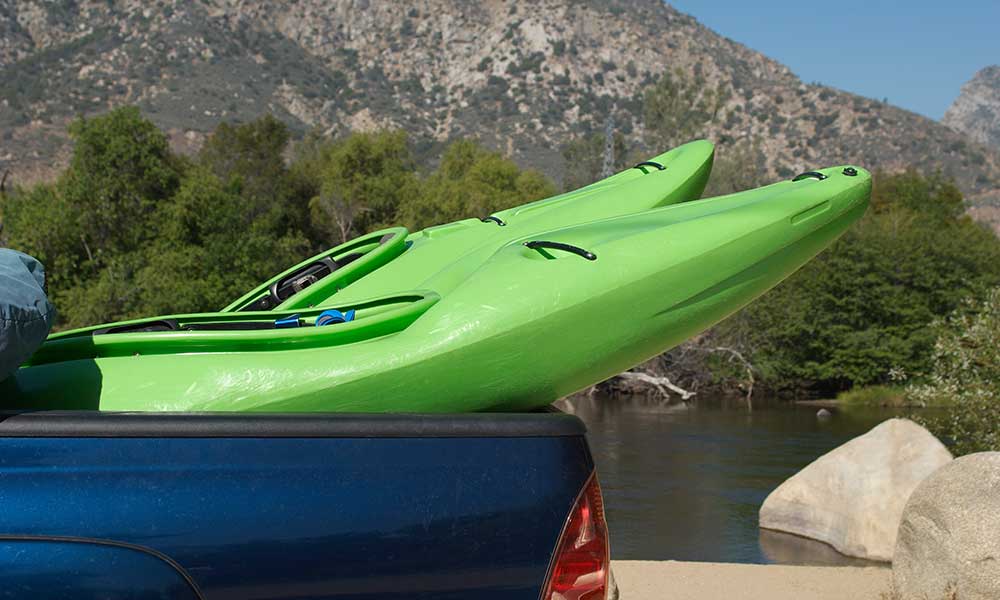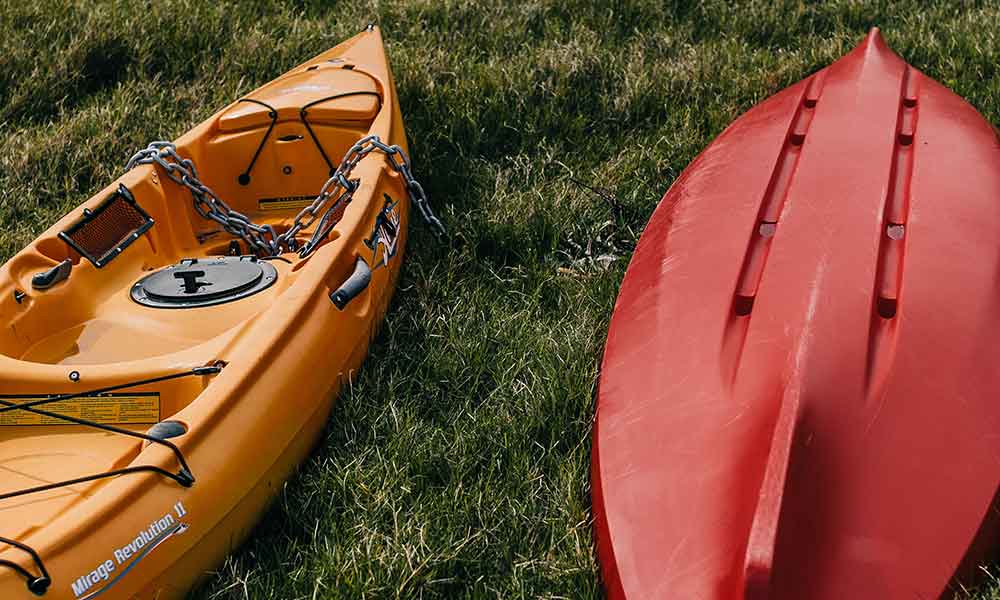Transporting a kayak can be a challenge, but it is a major part of owning a vessel like this. Many paddlers are always looking for the best transport methods for their boats and the best techniques for securing their kayaks to a vehicle. Let’s answer some of the most important kayak transport questions.
It is always best to transport a kayak with a roof rack and a kayak rack attachment such as a J-rack. These racks hold the kayak securely during transit. Always use ropes or straps to secure the kayak to the roof and to secure mounting points at the rear and front of the vehicle.
Tackling the challenge of kaya transport can be frustrating and scary at times, but with the proper techniques, methods, and equipment, overcoming this challenge is simple. Let’s cover the ins and outs of transporting a kayak safely using regular vehicles and equipment.
How To Put A Kayak On A Car
Securing a kayak onto the roof of a car for transport is an essential aspect of kayaking. Every paddler must have some way of transporting their boat to the water, and without a truck or trailer, using the roof of a car is the best option. What are the best ways to put a kayak onto the roof of a car?
The best ways to put a kayak onto the roof of a car include using a roof rack system that may include both crossbars and side rails, using J-racks, roof saddles, roof pads, stacker racks, or simply with some thick foam pieces and appropriate straps.
Transporting a kayak or multiple kayaks is always a challenge. These boasts are designed for the water, not for the hard, flat roof of a vehicle, and this makes kayaks very cumbersome and awkward to load up onto a car.
However, with the correct equipment and travel systems, as well as some clever techniques, transporting a boat on the roof of a car is not as much trouble as it seems.
How to put your kayak onto the roof of a car will depend entirely on what type o kayak you have, what type of car you are placing it onto, and what type of roof rack system, if any, is installed on the car.
Loading a kayak onto a car is typically easier with two people. In this instance, it is as simple as lifting the kayak and placing into onto the car and subsequently tying the kayak down securely for transportation.
Without an extra pair of helping hands, the process can be more challenging due to the size and length of most kayaks. In this instance, first balance one end of the kaya on the car, whether on the side or the back of the car and then move to the back of the boat and push it up onto the roof.
Pushing the kayak up from the side of the car will require turning the boat until it is parallel with the roof once it is upon the vehicle. Once the kayak is on the car, always tie it down securely to prevent the boat from sliding off of the car during transport.
There are several ways to put a kaya onto the roof of a car or any other vehicle. Let’s take the time to continue exploring the best methods for loading a kayak, or multiple kayaks, onto a car or into a truck, how to secure kayaks for transport, and a few tips and techniques that are helpful for making the process easier.
How To Transport A Kayak Without A Roof Rack
If you must somehow transport a kayak without the use of a roof rack, finding the best way to do it can be a challenge. Whether you are renting a kayak and a car during a trip, or you have to borrow a car without roof racks to transport your kayak, there are good ways to transport a kayak without a roof rack.
The most secure way to transport a kayak without a roof rack is to use a series of thick foam or sponge pieces or pads, ropes, ratchet straps or cam straps, and some form of mat, rug, or thick blanket to make the process easier.
A minimum of two foam or sponge pads is required for this method of transporting a kayak. To begin, place two foam pads on the roof of the vehicle that you will be using. Be sure that the pads are tall enough the bottom of the kayak will not come into contact with the roof.
Place the foam pads onto the roof of the car at the very back and very front edges of the roof centered on the vehicle, directly above the front and rear windscreens. These locations are best because this is where the roof supports within the vehicle are, and they will offer the most support beneath the boat.
The next step is to slide the vessel onto the roof of the car. The easiest way to get the kayak onto the roof is to use the rug or blanket to protect the car and slide the kayak up onto the roof from the rear of the vehicle.
Once the boat is safely on top of the foam pads, use your ratchet straps, cam straps, and sturdy ropes to secure the kayak to the vehicle. Tie the kayak onto the roof by looping straps around the kayak and around the roof of the car through the interior of the vehicle. Secure the bow of the kayak to the towing eye at the front of the car using rope for extra stability.
How To Attach A Kayak To A Roof Rack
Securing a kayak onto a roof rack is the best way to transport a kayak with a car. Attacking the kayak can be challenging, but following the right steps make the process much easier.
To attach a kayak to a standard roof rack system, follow these simple instructions:
Step 1: Place the kayak onto the car.
Lift the kayak onto the roof by lifting the stern of the boat to the front roof rack rail and wedging it between the roof and the rail.
Lean the boat against the car in this way and move to the back of the boat to lift the kayak up onto the roof. Turn the kayak so that the stern is at the rear of the car, and the kayak is centered on the racks.
Step 2: Secure the kayak to the roof rack.
Strap the kayak securely onto the roof rack system using ratchet straps, cam straps, or ropes. Slip a strap or rope under the front cross beam of the rack on one side of the bow of the boat and throw both ends of the strap or rope over to the other side of the kayak.
This forms a look around the rack and allows the rope to pass over the boat. Loop the strap around on the other side of the boat and secure the rope to the rack. Repeat the same step at the stern of the kayak.
Step 3: Tie the kayak to the towing eyes.
Further secure the kayak by tying the boat to the front and rear towing eyes of the vehicle. Using rope or a strap with S-hooks, securely tie the front and back of the kayak to the car towing eyes by using the handles on the boat. This prevents the boat from sliding off under braking or acceleration.
How To Load A Kayak On A J-Rack By Yourself
J-racks are an excellent expansion for roof racks that allow a kayak to be transported securely and allow space for two kayaks on the same rack.
Securing a kayak to a J-rack is similar to using a regular roof rack. First, place the kayak on its side within the J-rack and make sure the boat is centered.
Using cam straps, ratchet straps, or rope, secure the kayak to the rack by running the strap or rope through the top hoop of one of the J-racks, passing both ends of the strap or rope over the kayak, and securing the strap or rope to the roof rack after passing it through the opposite hoop on the J-rack.
Repeat the process at the other J-rack, and this will keep the kayak laterally secured. To further secure the kayak, locate the front and rear towing eyes of the vehicle, and attach a rope or strap to each towing eye with an S-hook or a tight knot.
Tie the other end of each rope or strap to the bow and stern of the kayak, respectively, and secure tightly.
The frame of the J-rack will help prevent the kayak from moving, and having tightly secured ropes or straps ensures that your kayak will not slip or shift at all during transport.
How To Strap Two Kayaks To A Roof Rack
Transporting one kayak on a roof rack is already a challenge but moving two at a time is often unavoidable. Moving two kayaks on a roof rack is not as difficult as it may seem at first. Let’s learn how to do it.
Having two kayas to strap onto a roof rack usually means that you have the other paddler with you to help make the process easier. This is a great help and drastically reduces the time this process takes.
Transporting two kayaks at once is best done using a kayak stacker attachment or J-rack attachments for roof racks. Without these attachments, moving two kayaks at once on a regular roof rack is dangerous.
Begin by loading one of the kayaks onto the roof of the car and assess the amount of space the roof of the car has. Some cars can hold two kayaks side by side, others require the kayaks to be placed on their sides, and others require one kayak to be secured flat and the other on its side.
If the roof rack is equipped with J-racks or a stacker, both kayaks will fit securely on their sides with no real trouble. Simply tie down both kayaks to their respective racks and secure them well to the towing eyes of the car.
If these rack attachments are not available, the kayaks will have to be secured to the rack individually. After assessing the space on the roof rack, secure the first kayak to the rack using the methods above. A good practice is to secure one kayak flat and the other on its side.
Once the first kayak is secured, preferably flat on the roof rack, mounting the second on its side allows both kayaks to be secured to each other and to the roof rack. Use the flat kayak as a stabilizer for the side-mounted kayak and secure it to the roof rack with ropes or straps.
Once the kayak is secure, use ropes to tie both kayaks together at their respective handles or eyelets. Once the kayaks are secured together, remember to always tie both boats to anchor points at the front and rear of the car or vehicle to prevent them from sliding off the roof. Towing eyes are ideal for this application.
How to Load A Kayak In a Truck
Loading a kayak into a truck bed is another ideal way for transporting a kayak safely. However, there are some critical considerations to make and vital aspects of the procedure to remember.
Loading a kayak into a truck is only possible without additional racks or bed extenders if the truck bed is long enough to accommodate the kayak. Some shorted kayaks fit well into truck beds by being lifted up onto the tailgate and secured tightly to anchor points within the truck bed.
If the kayak is too long for this approach, several truck bed extenders are available specifically for transporting kayaks. These extenders and racks mount to the underside of the vehicle and provide an extension for the kayak to be mounted onto, allowing the kayak to be mounted flat and not raised in any way.
Once the kayak is loaded onto the truck, either within the bed and on the tailgate or on an extender or rack, tying the kayak down with straps and ropes is a simple matter. Only be sure that the kayak is not able to shift or slide at all during transport.
How To Lock A Kayak To A Roof Rack
Locking a kayak onto a roof rack is important to prevent the kayak from being stolen during a rest stop and adds an extra layer of strength to the fastenings keeping the kaya secure on the roof rack.
Several rope locks, chain locks, and bicycle locks are available on the market that will lock a kayak to a roof rack securely, but the best option is to use a small chain and an anti-pick lock.
Loop the chain through a body hole in the kayak, somewhere that cannot be unscrewed and opened, such as a handle, and loop the other end through a strong section of roof rack.
Lock the chain with an anti-pic lock, and your kayak should be kept secure and safe while you are away.
Do You Need Bow And Stern Tie Downs For Kayaks?
When tying a kayak to any roof rack or mounting system on the top of a vehicle, securing the vehicle in two directions is vital.
For this reason, bow and stern tie downs are essential when transporting kayaks. Specialized tie downs are not necessary when ropes or regular straps will do fine.
These ropes or straps can either be attached to the front and back ends of the roof rack or to towing eyes or metal points at the front and back of the vehicle to hold the kayak securely in place.
Always attach the ropes or straps to secure and strong mounting pints on the bow and stern of the boat to prevent breaking any part of the kayak.
Conclusion
Transporting a kayak is part of owning a kayak. Everyone who enjoys taking their boat out on the water requires a means of getting the boat to the water first.
Strapping a kayak to a truck or car by means of a roof rack system is the best way to accomplish transport it safely and prevent damage to the kayak in transit. Always take the time to secure the boat properly to the car, regardless of how you mount it, and you should arrive safely without causing any damage to your kayak.







